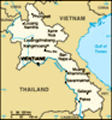Lao or Laotian Economy, Laos Economy
Advertisement
Economy - overview: The government of Laos - one of the few remaining official Communist states - began decentralizing control and encouraging private enterprise in 1986. The results, starting from an extremely low base, were striking - growth averaged 6% in 1988-2004 except during the short-lived drop caused by the Asian financial crisis beginning in 1997. Despite this high growth rate, Laos remains a country with a primitive infrastructure; it has no railroads, a rudimentary road system, and limited external and internal telecommunications. The government has sponsored major improvements in the road system. Electricity is available in only a few urban areas. Subsistence agriculture accounts for half of GDP and provides 80% of total employment. The economy will continue to benefit from aid from the IMF and other international sources and from new foreign investment in food processing and mining. In late 2004, Laos gained Normal Trade Relations status with the US, allowing Laos-based producers to face lower tariffs on their exports; this may help spur growth.
GDP: 0.5% (2004)
GDP - real growth rate: 6% (2004 est.)
GDP - per capita: Purchasing power parity - $1,900 (2004 est.)
GDP - composition by sector: Agriculture: 49.5% industry: 27.5% services: 23% (2004 est.)
Population below poverty line: 40% (2002 est.)
Household income or consumption by percentage share: Lowest 10%: 3.2% highest 10%: 30.6% (1997)
Distribution of family income - Gini index: 37 (1997)
Inflation rate (consumer prices):
Labor force: 2.6 million (2001 est.)
Labor force - by occupation: Agriculture 80% (1997 est.)
Unemployment rate: 5.7% (1997 est.)
Budget: Revenues: $284.3 million expenditures: $416.5 million, including capital expenditures of NA (2004 est.)
Industries: Tin and gypsum mining, timber, electric power, agricultural processing, construction, garments, tourism
Industrial production growth rate: 9.7% (2001 est.)
Electricity - production: 3.56 billion kWh (2002)
Electricity - production by source:
Electricity - consumption: 3.036 billion kWh (2002)
Electricity - exports: 400 million kWh (2002)
Electricity - imports: 125 million kWh (2002)
Oil - production: 0 bbl/day (2001 est.)
Oil - consumption: 2,750 bbl/day (2001 est.)
Oil - exports: NA
Oil - imports: NA
Oil - proved reserves:
Natural gas - production:
Natural gas - consumption:
Natural gas - exports:
Natural gas - imports:
Natural gas - proved reserves:
Agriculture - products: Sweet potatoes, vegetables, corn, coffee, sugarcane, tobacco, cotton, tea, peanuts, rice, water buffalo, pigs, cattle, poultry
Exports: $365.5 million (2004 est.)
Exports - commodities: Garments, wood products, coffee, electricity, tin
Exports - partners: Thailand 19.3%, Vietnam 13.4%, France 8%, Germany 5.3%, UK 5% (2004)
Imports: $579.5 million f.o.b. (2004 est.)
Imports - commodities: Machinery and equipment, vehicles, fuel, consumer goods
Imports - partners: Thailand 60.5%, China 10.3%, Vietnam 7.1%, Singapore 4% (2004)
Debt - external: $2.49 billion (2001)
Economic aid - recipient: $243 million (2001 est.)
Currency:
Currency code:
Exchange rates: Kips per US dollar - 10,820 (2004), 10,569 (2003), 10,056.3 (2002), 8,954.6 (2001), 7,887.6 (2000)
Fiscal year: 1 October - 30 September
Advertisement
The information here has been derived from Public Domain Sources such as the CIA World Factbook. No liability can be taken for any inaccuracies.
Tot: 0.025s; Tpl: 0.007s; cc: 3; qc: 2; dbt: 0.0052s; 1; m:domysql w:travelblog (10.17.0.13); sld: 1;
; mem: 1.1mb

 Laos was under the control of Siam (Thailand) from the late 18th century until the late 19th century when it became part of French Indochina. The Franco-Siamese Treaty of 1907 defined the current Lao border with Thailand. In 1975, the Communist Pathe...
Laos was under the control of Siam (Thailand) from the late 18th century until the late 19th century when it became part of French Indochina. The Franco-Siamese Treaty of 1907 defined the current Lao border with Thailand. In 1975, the Communist Pathe...
